#2021 chevy silverado single cab
Explore tagged Tumblr posts
Text
2021 Chevy Silverado Redesign, Wallpapers, Spy Shots
2021 Chevy Silverado Redesign, Wallpapers, Spy Shots
2021 Chevy Silverado Redesign, Wallpapers, Spy Shots | Encouraged for you to my personal blog, with this moment I will show you about 2021 Chevy Silverado. Now, this is actually the very first impression:

2021 Chevy Silverado Spy Photos | 1024 X 576
Think about impression previously mentioned? is usually that will incredible???. if you’re more dedicated so, I’l t show you many impression again…
View On WordPress
#2021 chevy silverado#2021 chevy silverado 2500hd#2021 chevy silverado concept#2021 chevy silverado interior update#2021 chevy silverado single cab#2021 chevy silverado zr2#2021 chevy ss truck
0 notes
Text
Pickup Trucks Getting Huge. Got Problem With That?
A FEW MONTHS ago, on an ordinary day in an unremarkable
Costco
parking lot, I was nearly squashed by an unusually large pickup. Thank God I was wearing a mask.
As that chrome grille closed on me like a man-eating Norelco shaver, time slowed. It seemed I was watching myself from afar, being nimble for a man my age, darting from the path of a towering, limousine-black pickup with temporary plates, whose driver barely checked his pace. Jerk.
What the hell was that thing? A 2020 GMC Sierra HD Denali? It was huge! The domed hood was at forehead level. The paramedics would have had to extract me from the grille with a spray hose, like Randall Jarrell’s ball-turret gunner.
He didn’t even see me.
Later, returning to my car, I noticed something: The parking lot was dotted with similarly enormous luxury pickups—many new, many taking up two spaces: Ram,
Ford,
Chevy, GMC. They stood out like Percherons in a herd of Shetland ponies.
“ Are pickups really getting bigger, on average, or do they just look scarier? Both. The average pickup gained 1,142 pounds between 1990 and 2019. ”
What is going on here? When did pickups get so big? And why are XL-sized pickups so big now?
I know. Pickup trucks at Costco. Film at 11. Except that in April, U.S. sales of pickups surpassed automobiles for the first time ever—about 112 years, give or take. Trucks and truck-based sport-utilities now account for roughly 70% of new vehicles sold in the U.S.
How we came to be Pickup Nation is a longer story (cheap gas, the Chicken Tax, IRS Section 179, marketing). But this year, to help move the tin during the pandemic, U.S. auto makers laid out a bounty of discounts and cheap financing, including 0% interest for 84 months and deferred-payment plans.
“Pickups without a doubt benefited from the great deals,” said Mark Schirmer, spokesperson for market service providers Cox Automotive. “And the deals were particularly great for consumers buying expensive vehicles.” The data suggest these incentives also juiced a boomlet in XL-sized, heavy-duty pickups, otherwise known as ¾-ton and 1-ton pickups, for private use.
That’s right: Gucci cowboys. Historically aimed at commercial customers, sole proprietors, horse-haulers and mega-RVers, heavy-duty pickups are stronger and taller than ordinary (half-ton) trucks, with cabs mounted high above reinforced frame rails and heavy, long-travel suspensions. But HD trucks have evolved in the past decade, irradiated with the same prestige-luxury rays as light-duty trucks.
Behold MotorTrend 2020 Truck of the Year, the Ram Heavy-Duty. In Limited trim (about $65,000 with four-wheel drive but before options) the 2500 HD sports an elaborate chromified grille that gleams like a tea service. Its flight deck glows with untrucky amenities such as acoustically insulated glass; active noise canceling; 12-inch center touch screen; wood trim, premium leather—all paired with a maximum 19,680-pound towing capacity. With the optional cab lights, it measures over 6-feet-9 inches tall.
Thus has been born a uniquely American vehicle type: the mega-luxury mega-pickup.
MEASURE FOR MEASURE
The dimensions of Chevy’s 2020 Silverado 2500 HD LTZ. Just how big?
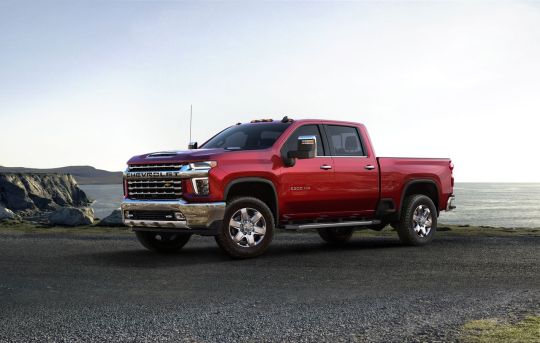
Photo: Chevrolet
81.85 in. wide
79.82 in. tall
249.95 in. long
It seems to be resonating. While sales of Silverado light-duty were off 18.6% in the second quarter, sales of the HD model sales were off less than a point. GMC’s light-duty Sierra was down 9.5%, while sales of our menacing new friend, the Sierra HD, were up 7.6% in the second quarter and 21.5% year-to-date.
Ford and
Fiat Chrysler Automobiles
don’t break out HD sales from pickups overall. However, Ram’s average transaction price in the second quarter soared above $50,000, according to a Cox Automotive analysis of data from Kelley Blue Book. Ford F-Series sales fell 23% (to 180,825 units) but its ATP was mostly unaffected—$51,688, the highest among pickups.
In July, J.D. Power declared Sierra HD the king of the bro-dozers, placing it first in its 2020 U.S. APEAL Study of Large Heavy-Duty Pickups, which tracks owners’ excitement and emotional attachment in the first 90 days.
“The front end was always the focal point,” GM designer Karan Moorjani told Muscle Cars & Trucks e-zine. “We spent a lot of time making sure that when you stand in front of this thing it looks like it’s going to come get you.”
Mission accomplished.
But are pickups really getting bigger, on average, or do they just look scarier? The answers are somewhat and definitely. The average pickup on the road gained 1,142 pounds between 1990 and 2019, according to the U.S. Department of Energy’s Oak Ridge National Laboratory, and 730 pounds since 2000.
“One of the most significant changes in that time was the arrival of crew-cab configurations, which added cab space to make them more family and work friendly,” said Mike Levine, Ford spokesperson.
In 2011, a change in the way the feds calculate vehicle fuel economy (the so-called “footprint rule”) gave domestic truck makers incentive to go big. Ever since, GMC, Chevy, Ram and Ford have been locked in a competitive feedback loop chasing best-in-class attributes and capacities—the “towing/hauling” wars. For MY 2019, for example, Ram’s 1500 Crew Cab gained 3.9 inches in overall length over a 4.1-inch longer wheelbase. In the same model-year, the Chevy Silverado gained 1.7 inches in length on a 3.9-inch longer wheelbase.
As a result, new light-duty pickup dimensions are approaching those of heavy-duty pickups. While the 2021 F-150 is about 18 inches shorter than the equivalent F-250, it is the same width (79.9). Mr. Levine noted that the company has gone to a common-cab design, using the same four-door living quarters for both light- and heavy-duty models.
“ ‘The face of these trucks is where the action is, a Chevy must shout Chevy. Every pickup has become a rolling brand billboard and the billboards are big.’ ”
Ask any kid with a crayon. If you draw the box in the middle bigger, you have to make the ones on the end bigger, too.
Which brings us to the 2020 Silverado HD—10 inches longer, 1.8 inches wider, and 1.6 inches taller than the previous model. The big Chevy’s challenging kisser comprises a thick, knee-high bumper; a central grille opening; several sets of lighting assemblies; a full-width transverse element helpfully informing with the message CHEVROLET…and then, above that, between very square corners, is a whole other layer, then a peaked hood with a central inlet. This hood line meets the base of the windshield about 6 inches above the side window sill.
Another cause of facial swelling? Marketing. “Full-size pickups are generally identical in profile,” Mr. Schirmer said. “The face of these trucks is where the action is; a Ford has to say Ford from head on, a Chevy must shout Chevy. Every pickup has become a rolling brand billboard and the billboards are big.”
You don’t have to be Steven Pinker to see that truck designers are leaning into the bully with these lantern-jawed bumpers and walls of chrome. Detroit’s blithe codifications of purposeful and powerful pickup design fail to describe the intimidation factor from the outside.
“A few brands, Ram and Ford, have taken to an overscale brand identity [and] applied it onto the grille,” said Kimberly Marte, associate professor of design at ArtCenter College of Design in Pasadena. “The Chevy team did benchmarking of new models and followed the trend.”
It’s not clear how long pickup designs can keep getting their chrome on. In 2018 the Insurance Institute for Highway Safety (IIHS) released a study examining the connection between SUV design and pedestrian fatalities. In a separate study released in June, IIHS found fatal single-vehicle crashes involving SUVs striking pedestrians increased 81% from 2009 to 2016.
While IIHS studied SUVs and not pickups, “The key is the geometry of the front end, the high and flat shape,” said Becky Mueller, a senior research engineer for IIHS. “It’s like hitting a wall.”
XL-pickups’ high-rising hoods also create significant blind spots just ahead of the vehicle. I know because apparently I was in one of them. While truck makers like Ford offer automatic emergency braking and pedestrian detection systems as standard equipment on most trims, and forward-view cameras as an option, such systems are not mandatory, as they would be in Europe.
NHTSA proposed that new pedestrian-safety tests for SUVs and trucks be included in the New Car Assessment Program in 2015. But as of this writing, the agency had not issued guidance on new standards. When asked, the industry trade group Alliance for Automotive Innovation had no comment.
And what if the next administration should issue pickup-pedestrian safety rules? Could the extra tall hoods and bluff grilles, the sightlines, the scale, the very form language of the traditional American pickup ever be made pedestrian safe? “Of course not,” said Ms. Marte. “No way.”
So watch yourself at Costco.
TOO BIG FOR ITS BRITCHES?
Sizing up Chevy’s 2020 Silverado 2500HD
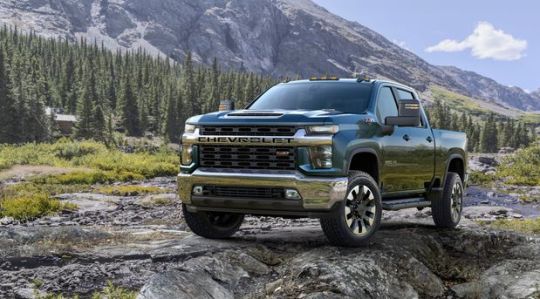
Photo: Chevrolet
HIGH-END HOOD: Modern pickups like the Silverado 2500 HD LT with Z71 Off-Road Package appear huge not just because roofs have gotten taller (topping out around 80 inches), but because hoods have grown relative to a truck’s overall height.
KING-SIZE BED: The 2020 Silverado 2500 HD Crew Cab with Standard Bed is 10.3 inches longer, 1.3 inches wider, and 1.6 inches taller than the 2019 model.
GAUDY GRILLE: The vast chrome rictus of Chevy’s Silverado has been coolly received by some critics and customers. But Silverado sales are up, and there’s a booming business in aftermarket grilles.
A STEP UP: To assist you in boarding its very tall seat—which maintains proportionality with the height of the hood, the 2021 Silverado HD High Country is available with power running boards that automatically slide out to meet you.
GRILLE MASTERS
The changing face of pickup trucks over the past century
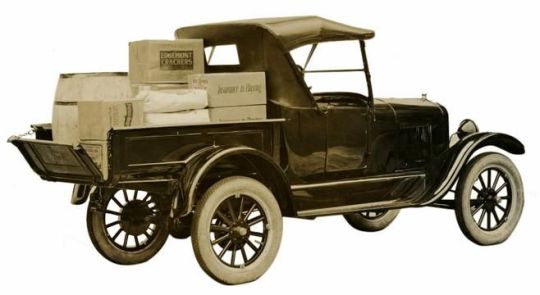
Photo: Ford Motor Company
1926: Ford Model T Runabout
Dearborn’s first pickup shared a distinctive radiator shape with the Model T, and sported a cargo box that measured 56 inches long by 40 inches wide.

Photo: Getty Images
1949: International Harvester KR-1
Old school even by 1949 standards, the KB-1 model got a little bling with chrome plated wings lateral to the grille and even a hood ornament.
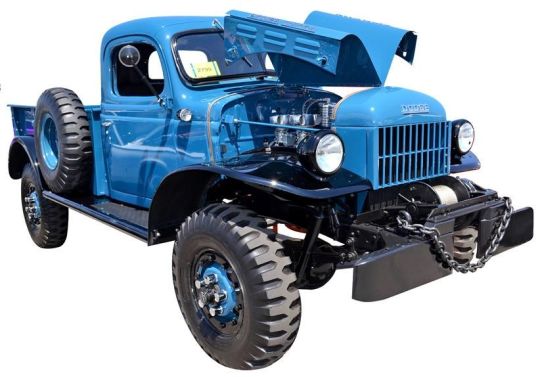
Photo: Getty Images
1949: Dodge Power Wagon
This medium-duty pickup was based on a WWII-era Dodge military truck and retained the “flat fender” for which they became known.

Photo: Alamy
1949: GMC Model FC pickup
Like competing Chevys of the era, GMC Trucks were fronted with “Bumper Bar” grilles—large horizontal bars surrounded by a thick frame on the top and sides.
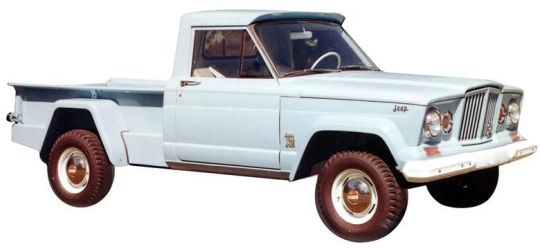
Photo: FCA US Media
1963: Jeep Gladiator J-200 Thriftside
Are you not entertained? The Gladiator’s early years featured the coolest grilles—centrally mounted, canted forward, with the Jeep badge in the lower-left.
MORE SWANK, LESS SCHLEP
How Ford’s uber-popular F-150 pickup has changed shape and style since 1995
PICKUPS AND SUVS have become the vehicles of choice for U.S. drivers over the last 25 years. Along the way, they’ve also become less trucklike, emphasizing comfort as well as capability. Take the F-150, the flagship of Ford’s F-Series, America’s bestselling vehicles 43 years running, which has morphed from rural work truck into a daily-driving people-mover as suburbanites ditched minivans in droves. The bestselling F-150 of 1995 was a rigid two-door set with a 6.5-foot bed; today’s bestselling F-150 has four doors, copious creature comforts, and a cargo box that’s a full foot shorter. —Aaron Stern
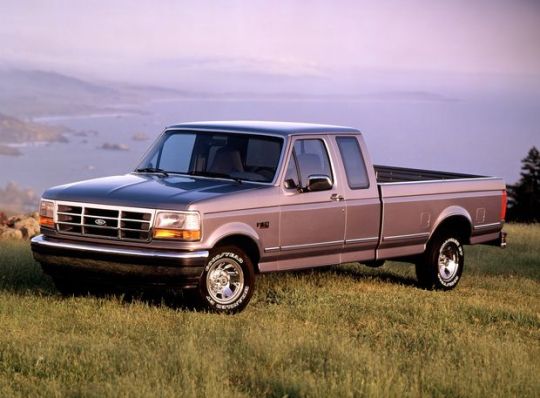
Photo: Ford Motor Company
1995 F-150 SuperCab XL 4×4
Length: 235” Width: 79”
Curb Weight: 4,600 lbs. Payload Box: 6.5’

Photo: Ford Motor Company
2020 F-150 SuperCrew XLT 4×4
Length: 231.9” Width: 79.9”
Curb Weight: 4,858 lbs. Payload box: 5.5’
Copyright ©2020 Dow Jones & Company, Inc. All Rights Reserved. 87990cbe856818d5eddac44c7b1cdeb8
%%
from Job Search Tips https://jobsearchtips.net/pickup-trucks-getting-huge-got-problem-with-that/
1 note
·
View note
Text
2021 Chevy Silverado lags behind the competition
New Post has been published on https://appradab.com/2021-chevy-silverado-lags-behind-the-competition/
2021 Chevy Silverado lags behind the competition
It’s a good-looking truck in RST trim, at least.
Emme Hall/Roadshow
The Chevrolet Silverado is a good truck, yet it’s still an underdog in the full-size pickup world. Capable and comfortable as it might be, Chevy just can’t compete with the fancy-pants Ram 1500 and do-it-all Ford F-150. But even so, the Silverado’s myriad configurations and distinctive design give it some genuine appeal.
Like
Smooth diesel engine
Lots of trailering tech
Plentiful charging options
Don’t Like
Limited driver-assistance tech
Lousy interior
Last-generation infotainment
The Silverado is available with no fewer than seven engine and transmission combinations, everything from a base 4.3-liter V6 and six-speed automatic to a 6.2-liter V8 with a 10-speed auto. The midrange 5.3-liter V8 is available with 6-, 8- or 10-speed automatics, and there’s a 2.7-liter turbo I4 on offer, as well. Beyond the underhood configurations, the Silverado is offered with single-, double- or crew-cab body styles. You can pair those with a 70-inch short bed, 79-inch standard bed or 98-inch long bed. Three axle ratios are offered and you can choose between two- and four-wheel drive.
For this review, I’ve got what’s arguably the best combination of the bunch: a 3.0-liter Duramax turbodiesel I6 with a 10-speed transmission and 4WD. I can’t overstate how much I love this engine. Pushing out 277 horsepower and 460 pound-feet of torque, there’s enough oomph to get this full-size pickup off the line quickly. Highway lane-changes are easy-peasy thanks to gobs of midrange torque, and this truck will hum along at highway speeds smoothly and efficiently.
With the diesel engine and four-wheel drive, the Silverado 1500 is estimated to return 22 miles per gallon in the city, 26 mpg highway and 24 mpg combined. With the crew-cab body, the Silverado has a 24-gallon fuel tank, so I could conceivably go 576 miles between fill-ups. The regular-cab truck gets a larger gas tank, and it’ll do nearly 700 miles in one stretch.
Generally speaking, the Silverado handles as well as any other truck. The brakes feel solid and linear under my foot, and the steering has a nice amount of weight and feedback. But Chevy could learn a few things from Ram when it comes to ride quality. The Silverado is floaty over bumpy pavement and every pothole is a jarring experience. You can get adaptive dampers, but only on the tippy-top Silverado High Country. A full air suspension, like the Ram’s, would really do a lot to make this truck more livable day to day.
Three cab configurations and three bed lengths are available.
Emme Hall/Roadshow
In terms of truck stuff, the Silverado is on the weaker side of competitive. When properly configured (two-wheel drive, long box), max payload is 2,280 pounds, while towing can get as high as 13,300 pounds (four-wheel drive, double cab, standard box, 6.2-liter V8). The Ram can haul up to 2,300 pounds in its bed and tow a max of 12,750 pounds. Meanwhile, the Ford F-150 can go as high as 3,325 pounds payload and 14,000 pounds of towing capacity, although, frankly, if you’re going to be towing that much on the regular, you’re better off stepping up to a heavy-duty truck.
My diesel-powered crew-cab tester can haul 2,060 pounds in its short bed and tow 9,000 pounds. A similarly spec’d Ram 1500 with the 3.0-liter EcoDiesel handles 1,800 pounds of payload and 9,710 pounds of towing, thanks to a 3.92:1 rear axle ratio (the Silverado’s diesel engine only goes to 3.23:1). The higher the rear axle ratio, the more low-end grunt you get. Ford’s 3.0-liter PowerStroke diesel in SuperCrew configuration can haul 1,805 pounds in the bed and somehow nets a 12,100-pound tow rating with 3.55:1 gearing.
However, the Silverado has a bunch of new technology for 2021 to make towing easier and safer. There’s a jackknife alert that helps while cornering and a trailer length indicator makes lane changes easier. A cargo bed camera makes it a cinch to hook up a fifth wheel trailer, and if customers install a camera on the rear of their trailer, they can see a behind-the-trailer view with guidelines and angle indicators right from the truck’s infotainment screen. Great as these are, however, the Silverado’s corporate twin — the GMC Sierra — offers more camera views. Still, Ford and Ram can’t match Chevy here.
The Duramax diesel engine is smooth and powerful.
Emme Hall/Roadshow
The Silverado gets its own version of GMC’s MultiPro tailgate for 2021, called Multi-Flex in Chevy-speak. But even without this, the standard tailgate is light and opens slowly. There are cut-out steps in the bumper to make climbing in and out of the bed easier, and my tester has a 120-volt, 400-watt outlet back there, in addition to 12 tie-downs and full LED lighting.
Where the Silverado really can’t keep up with Ford and Ram is with driver-assistance technologies. On the Chevy, adaptive cruise control is only offered on the very top trim, and things like forward-collision alert and lane-departure warning are optional across the board. Ram offers a lot more features, and don’t even get me started on the F-150, which has all the driving aids you can think of and can power an entire tailgating party if needed.
Interior tech falls short, too. A 7-inch infotainment screen is standard while an 8-inch display is optional. Thankfully, Chevy’s Infotainment 3 software is simple to use, and you can add wireless Apple CarPlay and Android Auto. But check out the impressive functionality of the 12-inch displays offered by Ford and Ram, and the Chevy just looks old by comparison.
This cabin is really dated.
Emme Hall/Roadshow
At least the charging options are good, with one USB-A, one USB-C, a 12-volt outlet and an AC outlet up front. There’s another USB-A and USB-C inside the center armrest, and additional USB-A and USB-C ports for rear seat passengers. Wireless charging is available, too.
But you guys, the Silverado’s interior is pretty terrible overall. This might as well have been lifted out of a 2015 Silverado. Hard plastics are everywhere and even the home button for the infotainment tech feels icky. It’s all just so cheap. Spend 5 minutes inside a Ram 1500 and you’ll wonder why Chevy isn’t trying harder.
There is, however, a ton of storage space. I can fit a couple of bottles in the door pockets, a wallet in the door handle, a tablet in the cubby on the transmission tunnel and my mom’s gigantic purse in the center armrest. There’s a place for small items just ahead of the cup holders and a little cubby on the dash, as well. Passengers get a dual glove box, although the upper box is not very deep and it seems things would easily fall out upon opening. The rear seat bottoms flip up to fit larger items in the back of the cab, too.
Pricing for the 2021 Silverado runs anywhere from about $30,000 on the base end to nearly $70,000 for a loaded High Country. My truck is a super-weird spec: a RST (which stands for Rally Sport Truck), paired with the Z71 off-road package and the diesel engine. Like, why would anyone try to combine a sporty on-road truck with an off-road package that adds Rancho shocks, hill-descent control and an upgraded air filter? It’s so strange.
The Silverado just can’t keep up with Ford and Ram.
Emme Hall/Roadshow
If you want off-road capability, go for the Silverado Trail Boss, which has a 2-inch lift, automatic locking rear differential and meaty 32-inch tires. You can’t get that trim with the diesel engine, though, and off-roading with a full-size pickup is pretty tough — unless you go for a Ford F-150 Raptor or Ram 1500 TRX. Personally, I’d just snag a diesel-powered Silverado LTZ with a few tech options, which puts me in the mid-$50,000 range. When it comes time to spec a full-size pickup, the world is pretty much your oyster.
Oh, and if you’re read this far and wonder why I haven’t mentioned the two other half-ton pickup options, the Nissan Titan and Toyota Tundra, it’s because they absolutely cannot compete in terms of utility, technology and powertrain options. I’m not really sure why you’d buy either of those.
Then again, I’m not really sure why you’d pick a Silverado over the Ford F-150 and Ram 1500. Hell, even its GMC Sierra twin is better-looking and a little nicer inside. Sure, the Chevy has a great diesel engine, nifty trailering tech and lots of interior storage space, but it’s several steps behind the competitors everywhere else. Until the Silverado gets a reboot, it’s not the truck I’d recommend.
0 notes
Text
The 2021 Cadillac Escalade’s New Diesel Engine: Everything You Need To Know
There probably aren’t many people who remember the last time Cadillac offered a diesel engine option for its coupe and sedans. Yes, for a brief period from 1978 to 1985 buyers could look forward to—if that’s the right perspective—a factory-installed oil burner borrowed from Oldsmobile in their Cadillac luxobarges. The 5.7-liter LF9 V-8 diesel could be had in the Eldorado, Seville, de Ville, and Fleetwood Brougham, and it was intended to pick off high-end car buyers who’d otherwise be flocking to Mercedes-Benz’s sturdy and luxurious diesel vehicles at the time. Today, Cadillac is giving diesel another try in its all-new 2021 Escalade SUV, and for similar reasons.
We’ll concede the idea that Caddy selling a diesel might be as difficult to fathom for Millennial Cadillac buyers who weren’t around nearly 40 years ago as it is for those older customers who were and suffered through that Malaise-era disaster. For the first time in its 21-year lineage, the Escalade is being offered with diesel power. In this case, it is a 3.0-liter Duramax turbodiesel inline-six. As the same engine comes in the next-generation Chevrolet Tahoe and Suburban (and their GMC siblings), it is paired with GM’s 10L80 10-speed automatic transmission.
Diesel by Duramax
This new LM2 engine was designed from the ground up in-house at GM. The block is constructed of cast aluminum, an oddity in a world where diesel engine blocks are commonly produced of the ultra-strong compacted graphite iron (CGI). Using aluminum nets a 25-percent weight savings over an iron block, and to aid longevity, GM added iron cylinder liners to cope with the 15:1 compression ratio.
A single set of dual overhead camshafts (it’s an inline-six, remember) operate each of the engine’s 24 valves, which feature maintenance-free finger followers and hydraulic lash adjusters. Owing to the engine’s length, the camshaft drivetrain is on the back of the engine. A chain drive on the crankshaft operates the high-pressure direct-injection fuel pump, and a chain on the fuel pump runs to the intake and exhaust cams. A smaller belt on the crankshaft runs the variable-flow oil pump.
Airflow is provided by way of a single, variable-geometry turbocharger, and a variable intake manifold provides two paths into each cylinder—a short one and a long one. Electronic flaps select which air path to use, improving engine response, particularly at low rpm. And fuel is provided by way of high-pressure common-rail direct injection, capable of multiple injection events per cycle and pressures up to 36,250 psi.
The LM2 inline-six’s 277 horsepower and 460 lb-ft of torque more than double up the figures of Cadillac’s original diesel from way back when. (That V-8 produced a downright pathetic, by modern standards, 125 ponies and 224 lb-ft of torque.) It also surely will deliver smoothness and low noise, vibration, and harshness (NVH)—the old GM diesel, by contrast, delivered seemingly maximum levels of those things.
How Much Will It Cost, and How Efficient Is It?
Even though pricing for the Escalade’s optional 3.0-liter Duramax diesel engine is forthcoming, we figure it won’t command much more than the $2,500 Chevrolet and GMC charge for it in the Silverado and Sierra pickup trucks. Fuel economy is the same story—while the pickups are EPA-rated for up to 33 mpg highway with the oil burner, final Escalade figures have yet to be released. Expect to see mpg numbers in the mid- to high 20s (at least) for the Cadillac.
With Escalade being roughly 1,000 pounds heavier than GM’s like-powered pickups (based on a crew-cab pickup versus a 2021 Suburban), it will be interesting to see whether there is a significant performance difference from a driving perspective when the time comes, and ultimately how real-world fuel economy varies between the trucks and high-end SUV.
More 2021 Cadillac Escalade
2021 Escalade First Look: Specs, Trims, and More
2021 Cadillac Escalade vs. 2021 GMC Yukon Denali, Chevy Tahoe High Country
2021 Escalade vs. Lincoln Navigator: Compared and Contrasted
2021 Escalade’s Giant, Curved OLED Screen: Fast Facts
Why the ’21 Escalade Says “600” on the Back
New Escalade vs. Mercedes GLS: Standard of the World?
The post The 2021 Cadillac Escalade’s New Diesel Engine: Everything You Need To Know appeared first on MotorTrend.
https://www.motortrend.com/news/2021-cadillac-escalade-duramax-diesel-engine-details/ visto antes em https://www.motortrend.com
0 notes